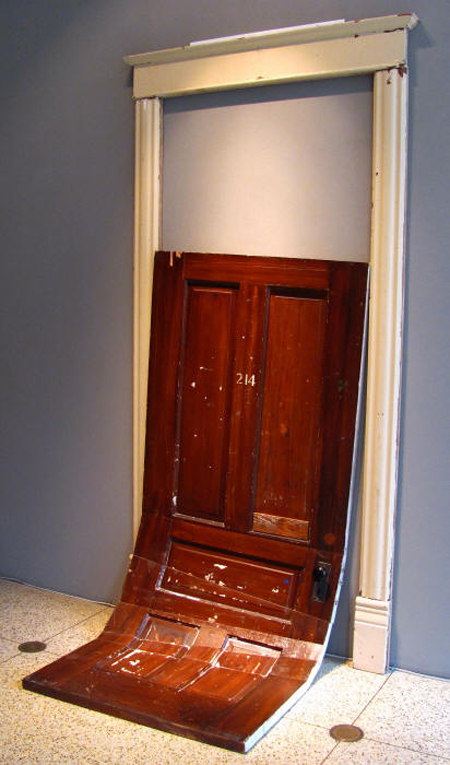
Continuing through May 11, 2013
In Aristotle Georgiades’ latest exhibition, “Some Time,” found residential materials and forms are uprooted and altered, ultimately recontextualized as symbols. In their original contexts, these were functional objects from our personal spaces that not only defined our environments, but facilitated an ease of existence and created comfort in our homes. However, here in the gallery, their utility has been stripped, with doorways and stairs transformed into portals and passages that lead viewers nowhere. Both familiar and markedly skewed, Georgiades’ works contain an inherent futility, employing the remnants of a past age to illustrate a stagnant present.
Georgiades has long been engaged with the notions of function and craft, and here he sources the components for his sculptures from domestic spaces: stair railings scratched and refinished many times over, chunky stacks of decorative trim, and flimsy apartment doors that are chipped and dinged with use. Though the materials selected predate the era of automated mass production, these original, individually-crafted objects are not masterpieces of design. Rather they’re barely decorative, nondescript, and likely originally intended for their cost effectiveness. These anonymous, outdated objects are often still in use, seemingly on their last legs and left to wait until structural failure forces an update.
In "Around" a squat wooden post is outfitted with a slim hand rail that spirals in on itself down the column. The railing visually guides the viewer along its futile, winding path, leading back to where it began. In a more perilous sort of futility, dry, bare branches “sprout” from a greying wooden ladder in "New Old Growth." The rungs that start out functionally at the base are impeded toward the summit, the branches’ sharp points prohibiting any possibility of using the ladder for its intended purpose. "In Bent Door," the eponymous object has been halved and reattached at an angle, lit from behind in order for the white light to stream through the cracks and the keyhole; the emanation’s source is hidden and enticing, but ultimately inaccessible. In a thorough disintegration of functionality, "214" features a shabby apartment door that is bent, slouching from its frame onto the floor. Not only is this door seemingly in mid-collapse, it leaves behind the empty trim surrounding not an entrance or an exit, but an impenetrable blank wall.
Like an old episode of "The Twilight Zone," Georgiades’ sculptures recall a specific bygone era and show us our world through uncanny metaphors. It’s especially poignant for Georgiades to be making these works in a contemporary context of international economic recession, and dormant manufacturing and construction, particularly in the Midwest. What makes Georgiades’ work so unsettling is a clear picture of the present, but no certain projections for the future. Brought to our attention is the fact that all around us, the obsolete lingers as the new has yet to come take its place.
